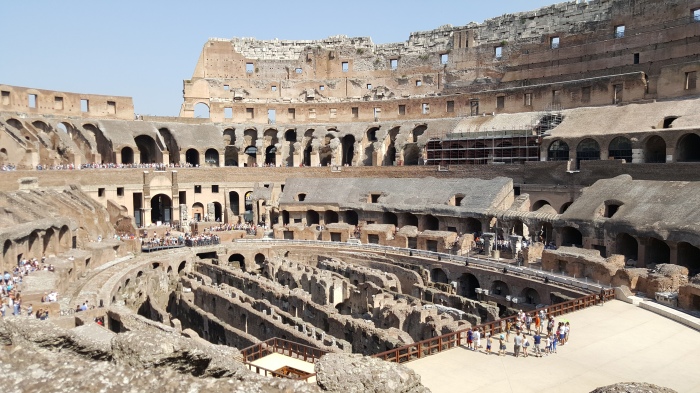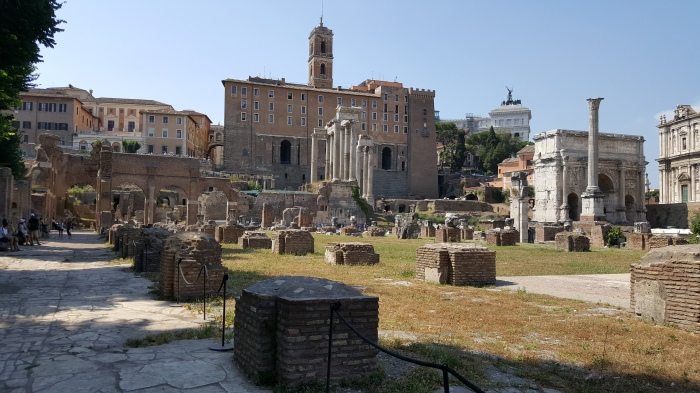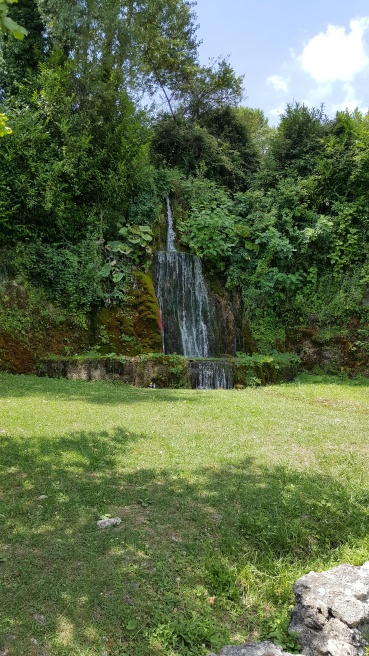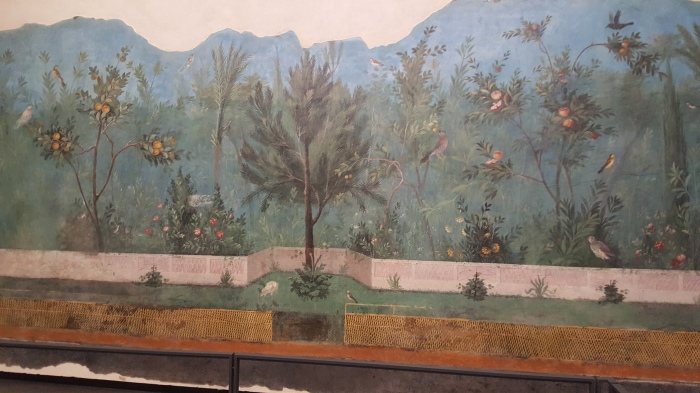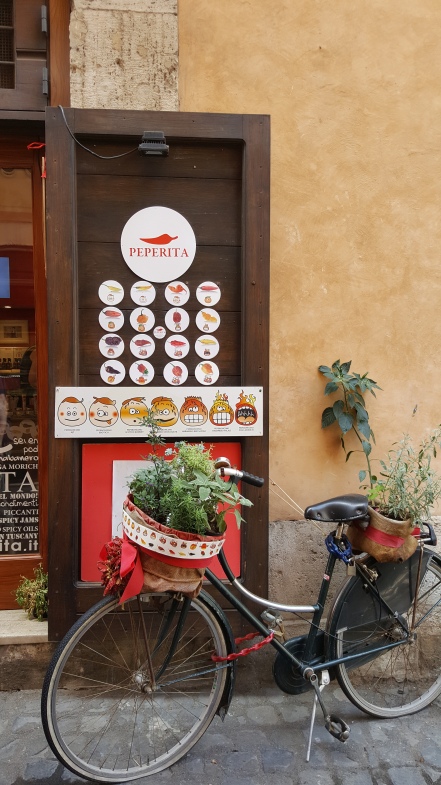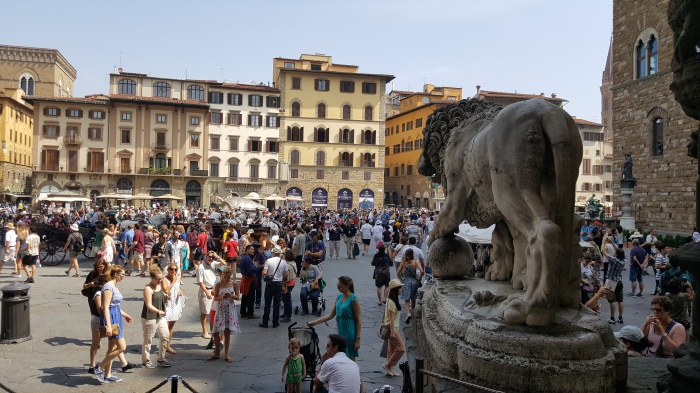What a week! Excuse my language but writing in Latin verse is fucking hard. I have so much new respect for Latin poets. It’s agonizing to write one line that makes somewhat sense, I can’t even imagine writing an epic filled with literary elegance. One whole week and I’ve written around 18 lines of poetry, multiple hours everyday have been devoted to verse composition and I have produced 18 metrically correct lines of poetry. I feel so accomplished. I know that having class for four hours in the morning and independent composition for four hours in the afternoon may sound boring but each day has slid past in the blink of an eye. It’s pretty amazing how time seems to speed up when your mind is intensely occupied by a challenge.
Our first day of classes was also my birthday, which to some of you, may sound like a bummer of a day for a birthday but it was honestly one of the best birthdays I’ve ever experienced. We had a delicious breakfast and dived right into verse composition with the introduction of the hendecasyllabic meter. This meter is incredibly restrictive and one of the more difficult ones to work with. I think our teacher, Dr. David Money, wanted to show us how restrictive and difficult poetry writing can be so that we can appreciate the freedom of the hexameter. Whenever he teaches us a new meter, D-Money (as we affectionately call him) presents us lines of some of his favorite poems in that meter. After a brief discussion, we then attempt to do a group composition. His skill in producing decent, quick verse is unparalleled and draw-dropping. On Thursday, he whipped out an Alcaic verse in like 15 minutes. It was mind-blowing.
We also learned about the metrical Haiku as was created by the poet Stephen Coombs. We are having a Haiku competition at the end of the workshop and whoever wins will receive eternal glory. I spent about 3 hours yesterday writing my Haiku. It’s only 17 syllables! WTF. But I’m actually pretty proud of it so I think I’ll share it on this post. It’s called ‘Labans in amorem’ or ‘Falling in Love’.
sicut volucris Just like a bird
pervolat aetheria, soars through the ether,
conscendimus sic thus we ascend
Yes, it took me three hours to compose that. But I feel very accomplished and satisfied and maybe I’ll even win myself some eternal glory. We also figured out that my name is an anagram with Lesbia, the star of many of Catullus’s poems. It was such a cool revelation moment that I’m honestly thinking about changing my Latin name to Lesbia.
Dinner was the best part, however. They hired a traditional Sicilian singer who serenaded us with traditional Sicilian folksongs! Her voice was absolutely angelic and it was so fun to hear traditional Sicilian, which is very different from Italian. After the secundo course and a couple of glasses of wine, she taught us a dance that used to be popular in Sicilian wedding parties. It was so much fun! She said that every lady needed a knight so we had to pair off and then she taught us the dance through the interpretation of our Italian expert, Kristine. I was even inspired to write a poem about it! Although, I’ve found that my poetic persona is rather dark and tends to send everything down into a dark spiral but nevertheless, I was still inspired by the dancing. Once we had finished dancing, our hosts brought out a magnificent cake and three bottles of prosecco. Thank god I wasn’t the only birthday this week, I don’t think I could have handled all that attention! The three of us blew out the candles together and then opened our bottles at the same time. It was such a fun night and I felt very special to be spending my birthday on an olive farm in Sicily. It’s definitely going to be hard to top in the future.
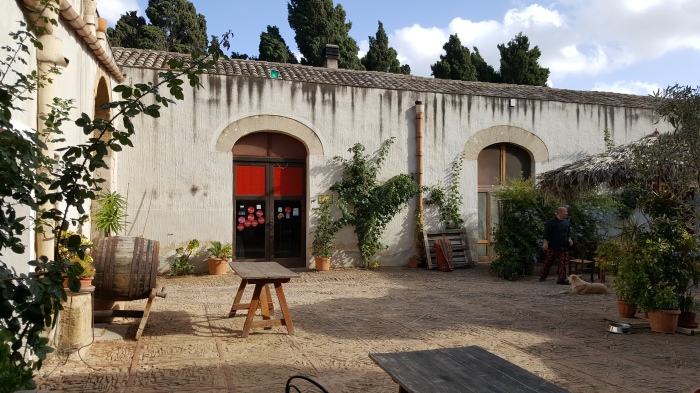
On Monday, we had our first excursion! Before we left, we had a session about the hexameter, the meter that the Aeneid is written in. Although it’s a lot more flexible than the hendecasyllable, it’s still pretty difficult. I don’t know how Virgil wrote so many verses, it’s so amazing. We actually do know how Virgil wrote the Aeneid. He wrote four lines everyday for 7 years, taking a day off every 10 days or so. He also wrote standing up. He sounds like a really weird guy. Our trip was to the island of Mozia, which is located in a small archipelago in a very large bay. It’s a fairly small island that has a museum with 6 rooms and lots of ruins all over the place. It took a leisurely 2 hours to walk around the entire island while also exploring the ruins and sites! It was a really fun but extremely hot day. It felt so good to move around after the massive amounts of food consumed in the past few days. We wandered around the island for a decent amount of time before getting on the ferry back to the mainland. Once we got back to home base, we immediately jumped into the pool, which felt so amazing. It was so refreshing and we soaked for a long time whilst exchanging riddles. Two of the participants are really into the lateral thinking riddles, which take a ridiculous amount of time and are actually rather difficult. Exempla gratia, the riddler would say, “He wouldn’t have died if he saw the dust”, and the participants are supposed to ask questions based on the statement in order to figure out the back story of the statement. As if Latin verse wasn’t enough of a challenge for our brains.

Tuesday was almost identical to Sunday. We had some discussions about how to transform an idea into a comprehensible poem PDM (pretty damn quick). We discussed things like style and word choice, things that were supposed to help us move along quickly in our poetry writing adventure. Most of the day was devoted to poetry composition, however. I think I finished my hendecasyllabic poem and began the one about dancing but I don’t really remember. My hendecasyllabic is about feasting and how the dangerous desire of food consumes us all. We had a tantum Latine prandium (Latin only lunch) and then a some more independent composition. There was also a group of people who were interested in doing a Horace poem set to music. I was planning on sitting and watching them sing because for those of you who know me, I have a terrible fear of singing in front of people and have always believed that I’m tone-deaf. But Eleanor and a new friend, Mikael, coerced me into joining the group and I sang in front of other humans for the first time in my adult memory. It was terrifying but really fun! I couldn’t believe that I made myself do that. I actually rather enjoyed it. We had a rather rowdy dinner because they kept bringing out the wine. We tried to go night swimming but were kicked out of the pool by a seemingly random person, who was also wearing a swim suit so it was very strange.
I stayed up way too late and had to get up early so we could go on our next excursion. But I felt surprising energetic for only getting about 3 hours of sleep and it turned out to be such a fun day! We went to a Ancient quarry site and then to Selinunte, which has one of the largest archaeological parks! It was so awesome. We got to climb all over the ruins of two ancient temples and then walk around a massive acropolis. My friend Eleanor and I captured some great touristy pictures of us looking like we’re leaning on giant pillars. All the stone used to build the temples came from the quarry that we visited right before the archaeology park so it was a cool connection to make! Selinunte is also close to the coast so we got to refresh ourselves with a lovely swim in the sea. Filled with a renewed sense of passion for the water, I even did some laps to the far out buoys! The only downside to the day was that I got slightly burned because all my sunscreen washed off in the water but it was definitely worth it.

On the way home, we stopped at this museum dedicated to the history of trade in Sicily and to the famous dancing Satyr bronze statue. It was a very tiny museum and had a small viewing area so that you could watch a documentary on the restoration of the dancing Satyr. It was probably one of the funniest videos I’ve ever seen. They had chosen an ominous, horror-movie, instrumental sound track when the camera panned all over the body of the Satyr. Whenever the music would climax, they would quickly flash the screen to another shot of the satyr’s body, usually a really weird, close-up of some body party. His nates (butt) were definitely the director’s favorite shot and I couldn’t contain myself the entire film. Eleanor and I were red-faced and dying from laughter by the end of the clip. Everyone was incredibly exhausted from the trip so we decided to substitute some rest before dinner instead of a poetry session. We were supposed to be learning about the iambic meter but the long day in the sun had turned everyone’s’ minds away from learning about Latin verse composition.
The next morning, we crammed the iambic meter and two of Horace’s lyric meters into the first class session. Iambic meters are mostly used in Greek tragedy and satirical poems and are rather restrictive. There are only certain feet where you can add variations to the meter, which makes it very uniform. There’s a very popular variation called the Limping Iamb where the last foot is reversed to give the meter a limping feel. It sounds really cool when done correctly but rather hard to do in practice. The other two meters are two of Horace’s favorite lyric meters, the Sapphic stanza and the Alcaic meter. The Sapphic stanza is taken from the Greek poetess, Sappho, and mostly used in lighter subject matters. The Alcaic is used for grand, serious, and public type of things. The Alcaic is definitely one of the toughest meters but David Money whipped out an entire Alcaic stanza in like 15 minutes at the end of class. It was amazing!
D-Money also introduced the inspiration hat during class. With a preamble containing many Harry Potter references, he asked us to all write down one or two concrete ideas for a poem and place them inside a hat. Whoever is lacking inspiration can then reach into the hat and pull out an idea! It’s a really fun resource to have and it’s very exciting to see what everyone’s ideas are. I think my idea was about being in a sunny meadow and smelling the flowers when suddenly a bee flies into your nose. But then you wake up and realize that the whole thing was just a dream. Or something like that.
That night we took a small field trip to Erice, which is a small, medieval mountain town right near Trapani. We drove into Trapani and then took a gondola up the mountain into the town! I thought my friend Evan was lying when he said we were riding up the mountain in a gondola. It was such a cool ride and pretty long too! We went just before sunset so we had about an hour to wander around the small town and then met at Erice’s castle, which overlooks the ocean and the surrounding country side. It was gorgeous, definitely one of the most amazing sunsets I’ve ever seen. The light was perfect and there was a slight fog over the water and horizon so the whole landscape looked ethereal. It’s almost hard to describe it was so beautiful! We also got to catch the rest of the sunset on the way down in the gondola, which was equally spectacular.

And then, subito, it was Friday! The last day! The week seemed to flash before my very eyes. I felt both ready and unwilling to depart for home. And then my new friend, Mikael, asked if I wanted to extend my trip and travel around Sicily with him, venturing into Palermo and Messina to see Scylla in the strait of Messina! Despite the fact that I’d already been in Italy for 6 weeks, I had to say yes. Who can refuse traveling around Sicily with a Swedish poet? Plus, I would also be able to hang out with my friends Diego and Eleanor, who were also going to be staying in Palermo. With some deliberation, calls to my parents, and a change of flight, I extended my trip! I’ve never felt more adventurous or spontaneous than in that moment. I almost feel like an entirely different person, which I think is a good thing! I’ve been revived from darkness with the light of travel and pursuit of knowledge and I’ve been renewed a newer and better person. Thank you, Italy!
Anyways, our last day was spent frantically trying to perfect poems to read at our public reading and rehearsing our choral piece for performance. We also had a small discussion about living Latin poet authors and what our next steps should be as Latin poets. It was a rather crazy day. But it was a very special day, culminating with our poetry recitation and a magnificent dinner with musical entertainment. Many of the other guests at Fontanasalsa even came to our performance and got to enjoy the fruits of the kitchen with us! We started off with our choral performance, which I think went pretty well. I was so nervous as I’ve never done any singing in front of people before but I had a lot of fun! My own poetry recitation also went well. I read my hexameter poem about learning how to dance. I’ll include the poem and its translation at the end of this post!

We had this absolutely amazing classical guitarist performance before dinner, which lasted probably over 30 minutes. It was a long ass concert but the music was absolutely gorgeous. During dinner, the same singer who sang at my birthday celebration came back and performed for us! There was also a chef making dessert right before our very eyes and surprised us all when he began singing with the lady. It was quite a picturesque evening and I was feeling quite emotional and overwhelmed from everything that happened. Many people were gearing up for a boozy night but I decided that I had to have some rest time. I also had to pack and there was no way I wanted to do that the next morning, especially after a late night. I’m so glad I did because my roommates didn’t come back to the room until almost 5am! That’s a late night.
During breakfast, the winners of the haiku contest were announced and I got 4th place! That’s actually slightly impressive because there were a ton of submitted poems so I’m happy with my small slice of eternal glory. With sad goodbyes and hopes of seeing each other in the future, we were off to the airport! I will have to recount my adventures with Mikael in another post, seeing as this one has taken me over a week to write. It’s been quite a busy 2 months for me and I’m starting to feel ready to return home. Although, Europe has taken slices of my soul and I’m not sure if I’ll ever reclaim them. This poetry workshop was absolutely life-changing, the details of which I might get into in the next post. But the last and final priority, my favorite poem that I composed!
Cognosco pedibus saltare et nocte priore
Consumpto vino deducet nunc vehementer
Musa figuram almam. Mox dulce per alsum
Luminis una hortum lunae florisque salimus.
Quamquam me studium movet, optant acriter artus
Sponte sua iactari quoquo. Nunc turbida fitque
Musa figuram abicit. Subito nunc aura silescit
atque in nigras lux stellae pallescerit umbras.
I learn to dance with my feet and on the prior night,
with wine consumed, the Muse now more vehemently
leads my pleasing form. Soon, through the cool garden of
moonlight and flowers, we dance sweetly together.
Although eagerness moves me, my limbs with to be thrown about
sharply by their own accord. Now, the Muse grows impatient and
abandons my body. Suddenly, the air grows silent
and the light of the stars fades into black shadows.
